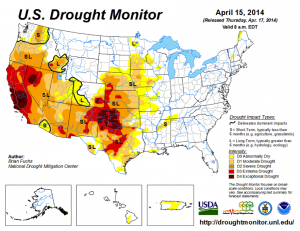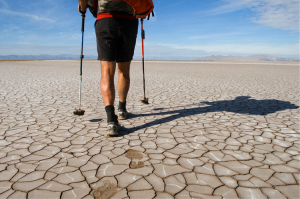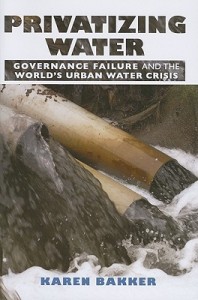When I met Nathaniel Meyer, I was curious about what brought him to work as Senior International Water Organizer at Corporate Accountability International, a non-profit dedicated to protecting human rights, public health, and the environment from corporate abuse. “It’s a bit of a story,” he chuckled, and settling into his chair, he told a story that transported me from a crowded coffee shop in downtown Boston to Kiribati, a small island nation in the central Pacific Ocean. According to Nathaniel, his childhood experience in Kiribati instilled in him a global perspective and a commitment to social and environmental justice that has inspired his career.
Nathaniel’s family temporarily moved to Kiribati in 1994, when he was in second grade. While the move from the forests of Central Maine to a tropical island was a big change, he quickly became close to some of the local people. Nathaniel remembers his best friend Thomas, a native I-Kiribati with a wide smile and bright eyes, with whom he would play tag in the sweltering sun.
Although he soon returned to the United States, Nathaniel did not forget his friends in Kiribati. In fact, he kept hearing Kiribati mentioned in the news in the context of climate change. Within 50 years, Kiribati is expected to be the first nation to lose all its land to rising sea levels.
When Nathaniel enrolled in Oberlin College in 2005, he was intent on learning as much as he could about climate change. He studied biology and environmental studies, but found himself less interested in the exclusively scientific portrayal of climate change narrated in parts per million. “Thomas’s face was in my mind,” Nathaniel explained. “I couldn’t stop thinking about how people I know are having their lives totally upheaved by climate change, and developed nations are at fault.” This realization turned Nathaniel away from scientific research and inspired him to work on social justice issues. Instead of just learning about how environmental issues were harming people, he wanted to find solutions to what he has come to see as a root cause of these problems: corporate greed.
At age 26, Nathaniel is a seasoned activist with experience organizing around several environmental and social justice campaigns. He learned to mobilize grassroots campaigns as a Field Organizer with GreenCorps, a field school for environmental organizing. During this year, Nathaniel cut his teeth as an organizer for the Sierra Club’s Beyond Coal Campaign at Penn
State’s University Park campus, in the heart of coal country. By recruiting and training student leaders, holding rallies, and working with the college administration and professors, Nathaniel succeeded in building the student support and momentum that led the university to commit to eliminating on-campus coal use. While fundraising and organizing with Environment Maine and the U.S. PIRG, he also helped to advance renewable energy policy and land conservation initiatives.
Driven by a commitment to creating a just and sustainable future, Nathaniel now works on Corporate Accountability International’s campaign to Challenge Corporate Control of Water. Nathaniel shares the non-profit’s belief that access to clean drinking water is a fundamental human right and that water corporations and their financial backers are exploiting the global water crisis by transferring public water systems into private hands that are motivated more by profit than the public interest. Since the rise of privatization in the 1990s, most projects – from Cochabamba, Bolivia to Manila, Philippines – have increased water prices and have neglected to provide water services to the poor. By privatizing water, corporations turn a basic human right into a commodity that few poor citizens in developing nations can afford.
Corporate Accountability International’s long-term goal is to defend democratic control of water, support critical reinvestment in public water systems, and fulfill the United Nations- recognized right to water around the world. A significant step toward this goal is challenging the World Bank, an international financial institution, to stop funding and promoting water corporations. If the World Bank stops propping up multinational water companies, there will be more of an opportunity to develop community-based, democratically accountable water systems. Nathaniel sees his work as “pressuring abusive industries in order to create space for positive examples to take hold.”
With this goal in mind, one of Nathaniel’s current projects is identifying and organizing supporters for the human right to water in US Congress. Nathaniel explains that, “when the World Bank changed its policies in the past, whether on tobacco or labor rights, it was pushed by champions in Congress.” In April, during the World Bank and International Monetary Fund’s Spring Meetings in Washington, D.C., Nathaniel met with legislators, including several who sit on committees with jurisdiction over World Bank practices, to convince them to join the call for the World Bank to stop backing water privatization.
While challenging one of the world’s most powerful international financial institutions is ambitious, Nathaniel believes that, with his organization’s support, he has the power to help make real change happen. Nathaniel describes Corporate Accountability’s greatest strength as its ability to “be strategic and have well-informed campaigns that leverage the power of large numbers of people to create pressure until a corporation can’t help but change.” The non-profit’s recent victories include helping to secure the adoption of the global Framework Convention on Tobacco Control, in addition to convincing the city of San Francisco and several prominent national parks to ban bottled water.
Although the outcomes of Nathaniel’s work as an international water organizer are far removed from where he lives in Boston, he takes inspiration from the passion and commitment that his colleagues and allied organizations abroad have to ensuring that all people have access to clean, affordable water. Nathaniel explains, “It’s tough not being on the ground, but I don’t need to be on ground necessarily.” Instead, he believes that he can make a big impact by working with allies to “change some of the structural issues that are making water systems dysfunctional.”
Forcing these corporations to change is difficult, but Nathaniel draws strength from past social justice movements in the US, such as the Civil Rights Movement, student protests against the Vietnam War, and campus divestments during South African apartheid. Young activists sparked and led all of these movements and achieved unlikely victories against great odds. Nathaniel concluded by saying that “It’s easy to feel powerless, but it’s also equally easy to feel powerful.”






